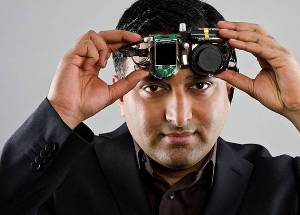All through his childhood, Ramesh Raskar wished fervently for eyes in the back of his head. “I had the notion that the world did not exist if I wasn’t looking at it, so I would constantly turn around to see if it was there behind me.” Although this head-spinning habit faded during his teen years, Raskar never lost the desire to possess the widest possible field of vision.
 Ramesh Raskar, who as a child wished for eyes in the back of his head, invents a camera that can see around corners. Photo: Len Rubenstein
Ramesh Raskar, who as a child wished for eyes in the back of his head, invents a camera that can see around corners. Photo: Len Rubenstein
Today, as director of the Camera Culture research group and associate professor of Media Arts and Sciences at the MIT Media Lab, Raskar is realizing his childhood fantasy, and then some. His inventions include a nanocamera that operates at the speed of light and do-it-yourself tools for medical imaging. His scientific mission? “I want to create not just a new kind of vision, but superhuman vision,” Raskar says.
He avoids research projects launched with a goal in mind, “because then you only come up with the same solutions as everyone else.” Discoveries tend to cascade from one area into another. For instance, Raskar’s novel computational methods for reducing motion blur in photography suggested new techniques for analyzing how light propagates. “We do matchmaking; what we do here can be used over there,” says Raskar.
Inspired by the famous microflash photograph of a bullet piercing an apple, created in 1964 by MIT professor and inventor Harold “Doc” Edgerton, Raskar realized, “I can do Edgerton millions of times faster.” This led to one of the Camera Culture group’s breakthrough inventions, femtophotography, a process for recording light in flight.
Manipulating photons into a packet resembling Edgerton’s bullet, Raskar and his team were able to “shoot” ultrashort laser pulses through a Coke bottle. Using a special camera to capture the action of these pulses at half a trillion frames per second with two-trillionths of a second exposure times, they captured moving images of light, complete with wave-like shadows lapping at the exterior of the bottle.
Femtophotography opened up additional avenues of inquiry, as Raskar pondered what other features of the world superfast imaging processes might reveal. He was particularly intrigued by scattered light, the kind in evidence when fog creates the visual equivalent of “noise.”
In one experiment, Raskar’s team concealed an object behind a wall, out of camera view. By firing super-short laser bursts onto a surface nearby, and taking millions of exposures of light bouncing like a pinball around the scene, the group rendered a picture of the hidden object. They had effectively created a camera that peers around corners, an invention that might someday help emergency responders safely investigate a dangerous environment.
Raskar’s objective of “making the invisible visible” extends as well to the human body. The Camera Culture group has developed a technique for taking pictures of the eye using cellphone attachments, spawning inexpensive, patient-managed vision and disease diagnostics. Conventional photography has evolved from time-consuming film development to instantaneous digital snaps, and Raskar believes “the same thing will happen to medical imaging.” His research group intends “to break all the rules and be at the forefront. I think we’ll get there in the next few years,” he says.
Ultimately, Raskar predicts, imaging will serve as a catalyst of transformation in all dimensions of human life — change that can’t come soon enough for him. “I hate ordinary cameras,” he says. “They record only what I see. I want a camera that gives me a superhuman perspective.”